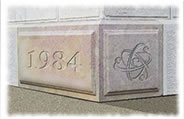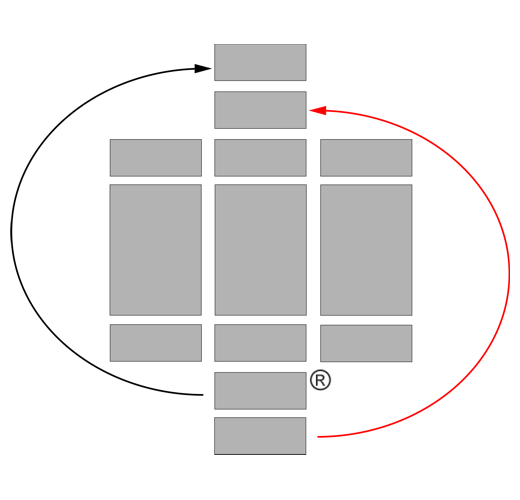Last Things First!℠
The “Back to Basics” Series
“Children, we’re taking the play on the road next week. This week, we pack the set and the costumes. Each of you has your own “tub” to pack. Make sure your character name is on the tub; and pack your entire costume and prop set! Listen very carefully now! The first thing you’ll put on during costume change is packed LAST! So, the Actors’ Rule for Packing is: ‘Last things first and FIRST things LAST!’”
—The Drama Teacher’s Road Warnings
Ron Taesch, Ph.D.
American Actor, Teacher and Dramatist
(Stephen Covey, of course, coined one of the most popular expressions of this admonition: “Begin with the End in Mind!” While we have great respect for Mr. Covey’s genius, we think Professor Taesch had a couple of points to make that take the old adage even further…)
Good advice for an aspiring actor, planning a road performance, and not a bad way to think about building a presentation as well. Why not start to write and compose in the same way we pack for a road show?
Don’t start at the beginning! The student actor who packs his underwear first is in for a big surprise when he has to dig around in the full bin to find them. If you write the opening first, you may find that the rest of the presentation morphs as you go — forcing you into a late night re-write to make the opening fit.
Consider, the only thing you really know for certain when you begin the composition process is how you hope the thing will end. What do you intend for the listeners to do? Start there! (Last things First!) This should show up in your presentation as the Next Step.
Then, you’ve got to ask, “OK, why on Earth will this audience do that?” The answer to that question will give you the keys to their hearts, minds and spirit — and should lead directly to your Main Idea. The “Why” they should do as you ask…
Anchor Points:
The Main Idea and the Next Step serve as the primary Anchor Points for the not-yet-formed presentation. But as details, topics and key points begin to show up and find their way into the structure, you mentally compare them to the Anchor Points to see if the new ideas “fit.” Are they Congruent with the desired outcomes? Are the new ideas Consistent? Do they make sense? (Coherence.)
If an idea “lines up with and points to” the Anchors, it stays! These internal tests of logic give you an easy set of tools for selecting what to keep and what to discard. A client tells us that sometimes ideas have a “magnetic lines of force” aspect; some immediately align themselves with the primary flow of logic, and others do not. Line up and stay, or be gone! Another client tells us that “Consilience” is a test: Do the ideas “Harmonize” or Do they “Rhyme?”
Having handled the body of the presentation, it’s finally time to consider First Things Last. So how will you tell them what this is about? How to state the Subject? We’ve noticed that there is usually a “harmonic concurrent vibration” — a “connectedness” between the Subject and the Next Step. So rely on that and concentrate on the Next Step. Now that you know where the presentation is going, and how you intend to get it there, how will you Label or Title it? This process reveals the usually workmanlike and practical statement of the Subject. The Next Step is practical and direct; but the Subject usually tends to be general — a BRIEF statement of what this is about.
Finally, the Opening. First Things Last! (Again, with that “Harmonic Connection.”) The Main Idea is “What This Thing is About!” The Ultimate Conclusion — Either Emotional or Rational. So, in considering this, What Question(s), Quote, Story, Joke or Historic Reference will help you set the stage for the ultimate revelation of the Main Idea? Start with the Main Idea, wait for the harmonics and magnetics to set in and indicate how you might begin. If it rhymes, if it vibrates, it stays!
OK, “Ending First; Beginning Last” — but only when composing!
Now it’s time to speak! Let the show go on!
Applications
1. Individually
It might be a carpentry project, a design job, a calligraphy assignment or a piece of homework. Ask yourself, did Doctor Taesch have it right? Should I begin this thing by thinking about the end?
2. At Home
Vacations come to mind — plan from the end back to the beginning, and you may find the entire event sweeter. What about family life — each event planned backwards from the end to the auspicious beginning? (We know, not everyone plans that much. But many of us have family members planning their children’s Ivy Graduation already — as the kids are entering kindergarten.)
3. At Work
Well sure, that’s where Fusion began — planning national meetings and team pitches — from the end, backward to the moment the other folks exited the elevator and headed for the conference room. It’s just easier! If you begin by thinking of how they’ll get out of the room and home after a favorable decision, it’s easier to plan how they’ll get in the room, and settle in for the pitch.
National meetings: Why not start the process by asking yourself what you want the national sales team to be doing Monday morning, the week after they return from the Conference? Then what will they have to learn at the conference to make that happen? And how should things begin when they settle in to the Grand Ballroom at the Waldorf?
It’s a meeting; it’s a conference; it’s packing or planning for a vacation; it’s a speech; it’s a presentation; it’s Theater on the Road! It may not repeat itself, but it rhymes!
However, and whenever you use it, the Key Rule is: “Last Things First; First Things Last!”
The Fusion Group LTD Box Diagram is a Registered US Trademark.
© 1985 The Fusion Group LTD. All International Rights Reserved.
Subscribe to our Newsletter


